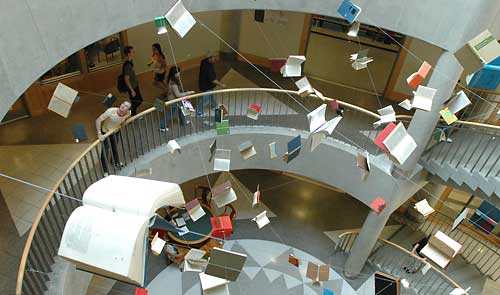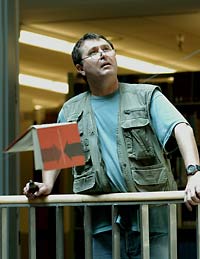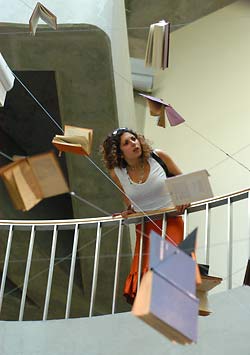UC Berkeley Press Release
 Books seem to fly through the staircase atrium leading down to the Gardner stacks in Doe Library in an art installation by J. Ignacio Diaz de Rabago, an artist-in-residence with UC Berkeley's Consortium for the Arts and the Arts Research Center. (Photos by Peg Skorpinski) |
Campus art installations feature 'flying books,' foam balls
BERKELEY – Students may wonder if they've spent too much time in the stacks when they glimpse hundreds of books floating in the air around the staircase that winds through three underground floors connecting the University of California, Berkeley's Doe and Moffitt libraries.
 '"Most of my work has to do with gravity, and to get free of gravity."' -J. Ignacio Diaz de Rabago |
The scene in the stairway of the Gardner stacks is the product of the imagination, design skills and physical labor of J. Ignacio Diaz de Rabago, an award-winning European artist well known for his large-scale, site-specific art installations.
Diaz de Rabago has created similar art before. He started with "Babel Library I," an exhibit of books suspended from transparent fishing lines at a gallery in Paris in 1997. His "Babel Library II" exhibit took place at the State Library in Stockholm in 1998, and the series grew to include "Babel Library VII, Tower of Books" in Sweden at the Central Library in Malmo (2001) and "Babel Library VIII, Pillars of Papers" at the University Library in Oslo (2002).
Still other projects have included bricks, bars, dust, stone, sacks, windows, a car and a tower of bicycles in such locations as Spain, Sweden and Amsterdam.
Diaz de Rabago and an interdisciplinary team of UC Berkeley students working with him on campus spent a day last week drilling holes in approximately 300 discarded and unsalvageable volumes that had been withdrawn from the library. They inserted a thin metal cable through each book, arranged them as directed by Diaz de Rabago, and used the stair's railings to help lower the books into place in the air.
Diaz de Rabago, trained as a sculptor and painter, is an artist-in-residence for six weeks with UC Berkeley's Consortium for the Arts and the Arts Research Center. He toured the campus some time ago, taking photos of potential sites for his art projects and mulling over ideas.
His final selections include the glass-enclosed spiral staircase of the Gardner stacks in Doe Library, where he said that he likes the light and proximity to the library's vast book collection, and the lobby of the recently restored Hearst Memorial Mining Building, which he chose for its beautiful architectural space. He said he also may choose the inner courtyard of Wurster Hall, in part for its "Brutalist style."
 A student pauses in amazement to view Diaz de Rabago's artwork filling the three-story subterranean staircase. |
The installation in Doe Library is Diaz de Rabago's first in the United States and will remain in place for close to a year. An installation involving suspension of foam balls in the Hearst Memorial Mining Building will follow later this week and remain there until July. No dates have been set for the Wurster work.
The Hearst and Wurster projects will be open to the public. The Gardner stacks, however, are open only to faculty, staff and students, but the library will allow visitors to view the installation from the upper level. On Cal Day (Saturday, April 16), the campus's annual open house, the stacks will be open to all, and the art work will be visible from every angle.
University Librarian Tom Leonard was excited about the Gardner stacks project, noting that online images of Diaz de Rabago's previous work "take your breath away."
Visitors to the recently restored North Reading Room typically respond with a "wow," Leonard said, "and if they say that about this exhibit, too, I think that's great."
W. Mike Martin, a UC Berkeley professor of architecture and chair of the architecture department, met Diaz de Rabago in Copenhagen, Denmark, about six years ago. He said he was instantly impressed by the aesthetics, breadth, discipline, values and visualization of Rabago's work.
"It's simple, yet extremely beautiful," Martin said.
About three years ago, Diaz de Rabago met Anthony J. Cascardi, a UC Berkeley professor of comparative literature, rhetoric, Spanish and Portuguese, and director of the Consortium for the Arts and its research center. Cascardi said he was giving a lecture in 2002 in the University of Copenhagen's Department of Romance Languages. Diaz de Rabago, a native of Spain who now lives in Copenhagen, attended. Afterward, the artist introduced himself and showed Cascardi a photograph of some of his art.
"I instantly started imagining something like it down in the atrium staircase of the (Gardner) stacks," recalled Cascardi, who later contacted Martin and Berkeley Art Museum Director Kevin Consey about bringing Diaz de Rabago to campus.
A plan for a plume of open-faced books piled on the floor and rising to the ceiling was nixed by estimated scaffolding costs and concerns about fire danger and safety.
That's when Diaz de Rabago came up with the idea of suspending books in mid-air. Cascardi said it is part of Diaz de Rabago's ongoing exploration of what it means to exist in a world with gravity as a pervasive force, as well as what it means for thoughts to be embodied in material form.
"Most of my work has to do with gravity, and to get free of gravity," Diaz de Rabago said over coffee at Cafe Strada near campus. "I like to make things flying or be without weight."
Since 1996, he has worked primarily with books. "Now I know the stomach of the books, how they smell, and I look at books in a new, physical way," he said.
"There's a wonderful freshness and innocence about a lot of the work he does," Cascardi said, commending Diaz de Rabago for finding new ways to use materials indigenous to his installation spaces. "He makes art in places that you don't expect to find it, and it takes you by surprise, reawakening your attention to spaces you're in every day."
Several free, public programs about Diaz de Rabago's work will be held on campus. He will give a slide show about his artistic practice and philosophy at 7:30 p.m., Monday, April 11, in Room 160 in Kroeber Hall. Diaz de Rabago, Cascardi and Mark Treib, a UC Berkeley professor of architecture, will talk about Diaz de Rabago's past work and his campus installations at 5 p.m., Thursday, April 14, at the Townsend Center for the Humanities, in Room 220 of Stephens Hall.
Diaz de Rabago's sketches for proposed campus installations will be on display at the Townsend Center April 14-May 25.
Samples of Diaz de Rabago's work can be found online at http://www.rabagoarte.com/.

